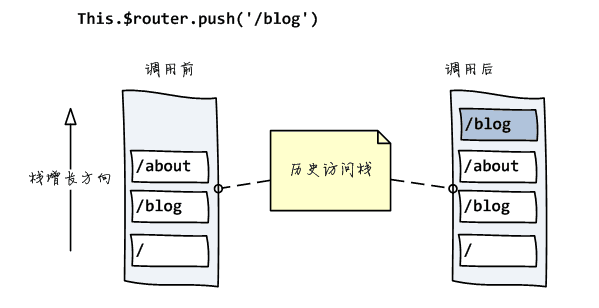Vue-router原理了解一下:
找到一篇文章,分析的很透彻 从vue-router看前端路由的两种实现,文章写的很好,看完这篇文章 ➕ 看源码应该可以理解,这里根据我浅显的理解概括一下:
vue-router通过hash与History interface两种方式实现前端路由,更新视图但不重新请求页面”是前端路由原理的核心之一,目前在浏览器环境中这一功能的实现主要有两种方式
-
hash---- 利用URL中的hash(“#”) -
利用
Historyinterface在 HTML5中新增的方法, 详情点击
那么,我们要选择用哪种方式呢?
在vue-router中,它提供mode参数来决定采用哪一种方式,选择流程如下:
mode 参数:
-
默认hash
-
history 注:如果浏览器不支持history新特性,则采用hash方式
-
如果不在浏览器环境则使用abstract(node环境下)

我们看看源码就知道了
// 根据mode确定history实际的类并实例化 // 根据mode确定history实际的类并实例化 switch (mode) { case 'history': this.history = new HTML5History(this, options.base) break case 'hash': this.history = new HashHistory(this, options.base, this.fallback) break case 'abstract': this.history = new AbstractHistory(this, options.base) break default: if (process.env.NODE_ENV !== 'production') { assert(false, `invalid mode: ${mode}`) } }
HashHistory
HashHistory真是身怀绝技,会很多东西。特别是替换路由特别厉害。还可以通过不同的方式,一个是 push ,一个是 replace .
两个方法:HashHistory.push() 和 HashHistory.replace()
HashHistory.push()将新路由添加到浏览器访问历史的栈顶

从设置路由改变到视图更新的流程:
$router.push() --> HashHistory.push() --> History.transitionTo() --> History.updateRoute() --> {app._route = route} --> vm.render()
1 $router.push() //调用方法 2 HashHistory.push() //根据hash模式调用,设置hash并添加到浏览器历史记录(添加到栈顶)(window.location.hash= XXX) 3 History.transitionTo() //监测更新,更新则调用History.updateRoute() 4 History.updateRoute() //更新路由 5 {app._route= route} //替换当前app路由 6 vm.render() //更新视图
HashHistory.replace()
replace()方法与push()方法不同之处在于,它并不是将新路由添加到浏览器访问历史的栈顶,而是替换掉当前的路由

replace (location: RawLocation, onComplete?: Function, onAbort?: Function) { this.transitionTo(location, route => { replaceHash(route.fullPath) onComplete && onComplete(route) }, onAbort) } function replaceHash (path) { const i = window.location.href.indexOf('#') window.location.replace( window.location.href.slice(0, i >= 0 ? i : 0) + '#' + path ) }
领教了HashHistory的超能力,接下来看下
HTML5History
History interface是浏览器历史记录栈提供的接口,通过back(), forward(), go()等方法,我们可以读取浏览器历史记录栈的信息,进行各种跳转操作。
从HTML5开始,History interface有进一步修炼:pushState(), replaceState() 这下不仅是读取了,还可以对浏览器历史记录栈进行修改:
window.history.pushState(stateObject, title, URL)window.history.replaceState(stateObject, title, URL)
-
stateObject: 当浏览器跳转到新的状态时,将触发popState事件,该事件将携带这个stateObject参数的副本
-
title: 所添加记录的标题
-
URL: 所添加记录的URL
1.push
与hash模式类似,只是将window.hash改为history.pushState
2.replace
与hash模式类似,只是将window.replace改为history.replaceState
3.监听地址变化
在HTML5History的构造函数中监听popState(window.onpopstate)
两种模式比较
在一般的需求场景中,hash模式与history模式是差不多的,但几乎所有的文章都推荐使用history模式,理由竟然是:"#" 符号太丑...0_0 "
如果不想要很丑的 hash,我们可以用路由的 history 模式 ——官方文档
当然,严谨的我们肯定不应该用颜值评价技术的好坏。根据MDN的介绍,调用history.pushState()相比于直接修改hash主要有以下优势:
-
pushState设置的新URL可以是与当前URL同源的任意URL;而hash只可修改#后面的部分,故只可设置与当前同文档的URL
-
pushState设置的新URL可以与当前URL一模一样,这样也会把记录添加到栈中;而hash设置的新值必须与原来不一样才会触发记录添加到栈中
-
pushState通过stateObject可以添加任意类型的数据到记录中;而hash只可添加短字符串
-
pushState可额外设置title属性供后续使用
作者:Searchen
链接:https://www.jianshu.com/p/4295aec31302
来源:简书
简书著作权归作者所有,任何形式的转载都请联系作者获得授权并注明出处。